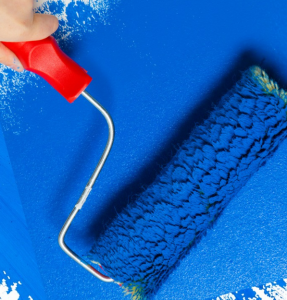How Often Should I Repaint My Home's Interior in Palm Harbor?





 Keeping your home’s interior looking fresh and well-maintained is about more than just style—it’s about preserving your home’s value, protecting surfaces, and creating a comfortable environment. If you’re wondering how often different rooms should be repainted, you’re not alone. As a trusted Painting Contractor Palm Harbor FL, we frequently get this question from homeowners who want to stay on top of maintenance while maximizing value and aesthetic appeal.
Keeping your home’s interior looking fresh and well-maintained is about more than just style—it’s about preserving your home’s value, protecting surfaces, and creating a comfortable environment. If you’re wondering how often different rooms should be repainted, you’re not alone. As a trusted Painting Contractor Palm Harbor FL, we frequently get this question from homeowners who want to stay on top of maintenance while maximizing value and aesthetic appeal.
In this guide, we’ll help you understand the ideal repainting timelines for various rooms in your Palm Harbor home. We’ll also explain how factors like humidity, sunlight, and traffic affect durability—and offer expert tips to extend the life of your paint.
Why Repainting Matters in Palm Harbor’s Climate
Florida’s tropical and subtropical climate presents unique challenges for interior paint. Even though your walls are indoors, humidity, salt air, and sun exposure can still take their toll. Here’s how:
- Humidity can lead to mildew and bubbling paint in poorly ventilated areas.
- Salt air, especially in coastal areas, can deteriorate finishes over time.
- Strong sunlight can fade interior walls near windows or sunrooms.
- Frequent air conditioning can also dry out certain surfaces, leading to cracking.
These environmental factors make regular interior repainting more than just a cosmetic upgrade—it’s preventive maintenance.
General Repainting Guidelines by Room
Each room in your home has different functions and wear patterns. Below is a breakdown of how often you should repaint each space, along with the reasons why.
1. Living Room and Dining Room
Repaint every 5–7 years
These spaces tend to have moderate traffic and are often decorated with furniture or art that protects walls from damage. If you use high-quality paint and a professional application, the finish can last quite a while.
Tips:
- Use eggshell or satin finishes for durability and easier cleaning.
- Keep an eye on walls that get direct sunlight, which can fade colors more quickly.
2. Kitchen
Repaint every 3–4 years
Kitchens are exposed to heat, steam, grease, and food splatter, which can degrade paint faster. Cabinets and trim may also need attention depending on how frequently they’re cleaned or used.
Tips:
- Choose washable, mildew-resistant paints with satin or semi-gloss finishes.
- Ventilate properly during and after cooking to reduce moisture buildup.
3. Bathroom
Repaint every 3–4 years
Bathrooms experience constant moisture and humidity, which can lead to mildew and paint peeling, especially on ceilings and around tubs and showers.
Tips:
- Use specialty bathroom paints that resist mold and mildew.
- Apply a satin or semi-gloss finish for extra moisture protection.
- Install or maintain good ventilation systems to extend longevity.
4. Bedrooms
Repaint every 5–8 years (adults)
Repaint every 2–4 years (children’s rooms)
Adult bedrooms typically see less wear and tear, but children’s rooms are a different story. From fingerprints and crayon marks to toy damage, these walls take a beating and need more frequent refreshing.
Tips:
- For kids’ rooms, consider scrubbable paint finishes like semi-gloss.
- Allow kids to participate in color selection to make repainting more exciting and personal.
5. Hallways and Corridors
Repaint every 2–3 years
These are high-traffic areas subject to frequent contact, scuff marks, and dirt buildup. Their paint breaks down faster than in most rooms.
Tips:
- Choose durable, stain-resistant paints.
- Install chair rails or wainscoting to protect lower wall sections.
6. Ceilings
Repaint every 7–10 years, or sooner if you notice discoloration.
Ceilings are often overlooked but can develop stains, cracks, or mildew over time. In Florida, humidity can cause mildew stains, especially in bathrooms and kitchens.
Tips:
- Use flat, mold-resistant ceiling paint.
- Be proactive about repainting if you see yellowing or gray spots.
7. Trim, Baseboards, and Doors
Repaint every 2–4 years
These surfaces see constant contact—shoes, furniture, vacuums, hands—and get dirty fast. Repainting them can give your entire interior a refreshed look without doing the full walls.
Tips:
- Use semi-gloss or high-gloss finishes for easier cleaning.
- Touch-up kits are great for handling scuffs between full repaints.
Signs It’s Time to Repaint
Even if you’re not on a schedule, your home will often tell you when it’s time for a refresh. Look for:
- Peeling or bubbling paint
- Faded colors
- Cracks in the paint or drywall
- Water stains or mildew
- Persistent odors (from mildew or smoke)
If you notice any of these, it’s time to call in a professional Painting Contractor in Palm Harbor FL.
Choosing the Right Paint for Interior Longevity
Florida’s humid interior environments require more than just any old can of paint. Here’s what to look for:
1. Mildew-Resistant Formulas
Brands like Sherwin-Williams, Benjamin Moore, and Behr offer mildew-resistant interior paints, which are perfect for bathrooms, kitchens, and laundry rooms.
2. Low-VOC or No-VOC Paints
These paints reduce indoor air pollution and are safer for families, especially those with allergies or pets.
3. Scrubbable Finishes
Opt for satin, semi-gloss, or gloss finishes in high-traffic areas. These are easier to clean without damaging the paint.
Tips to Extend the Life of Your Interior Paint
Want your paint job to last as long as possible? Here’s how:
1. Clean Walls Regularly
Use a damp microfiber cloth or sponge to gently remove dust and smudges. Avoid harsh chemicals.
2. Control Humidity
Invest in a dehumidifier or improved ventilation to minimize moisture damage and mold growth.
3. Use Quality Paint
Never cut corners on paint quality. Premium paints contain better binders, pigments, and protective additives that make them last longer in humid environments.
4. Touch-Up Between Paint Jobs
If the rest of your room still looks great, you can often get away with touching up instead of repainting entirely.
Professional vs. DIY: What’s the Better Option?
Why Hiring a Professional Pays Off
While repainting your home’s interior may seem like a manageable DIY project, hiring a Painting Contractor in Palm Harbor FL offers several benefits:
- Flawless finish without brush strokes or roller marks
- Proper surface prep including patching, sanding, and priming
- Efficient and timely completion
- Expert color matching and recommendations
When DIY Might Be Okay
If you have the right tools, time, and a simple room to paint (like a closet or garage), DIY can be a rewarding option. However, for detailed spaces, trim work, or humidity-prone areas, it’s best to leave it to the pros.
Keep Your Interior Fresh and Functional
A fresh coat of paint does wonders for your home’s interior—both visually and functionally. Regular repainting ensures your home stays protected from Florida’s unique climate challenges and continues to feel inviting and clean. By following room-specific timelines and working with a trusted Painting Contractor Palm Harbor FL, you can enjoy a beautiful home year-round with less maintenance and greater comfort.
Up Next:
Does new paint increase your home’s value? In our next post, we’ll explore Does Exterior Paint Increase My Home’s Value in Palm Harbor, FL? and how a well-executed paint job can boost both curb appeal and property resale value.

100% Satisfaction Guarantee

Licensed and Insured

Color Consultation

3 Year Warranty
Services

Our team of experts does popcorn ceiling removal and wallpaper removal. We also do drywall and stucco repairs as well as texturing, soffit and fascia repair.
Painting Service Locations

How long does it take to paint my house?
What is included with your free estimate?
All of our estimates include a fully detailed scope of the work to be completed. You will receive a report with a breakdown of the cost and time estimated for your project.
How do I get my project scheduled?
Simply follow the steps in the estimate to schedule or give us a call, text, or email. Whichever is convenient for you works for us.
Why does a house have to be pressure washed before painting?
If you’re planning to paint the exterior of your home, you may be wondering why pressure washing is such an important step. After all, a little dirt and grime shouldn’t stop the paint from sticking, right? Unfortunately, it’s not that simple. Over time, dirt, mildew, and other pollutants can build up on the surface of your home, causing the paint to chip and peel. Pressure washing removes this build-up, giving the new paint a clean surface to adhere to. In addition, pressure washing also helps to remove any chalky residue left behind by old paint. This ensures that the new paint will have a smooth, even finish. For these reasons, it’s always best to have your home professionally pressure washed before painting
Item How often does a house need to be repainted?
The frequency with which a house exterior needs to be repainted depends on a number of factors, including the type of paint used, the climate, and the level of exposure to sun and rain. In general, however, most experts recommend repainting every three to five years. High-quality paints that are properly applied can last for about 10 years, while lower-quality paints may last less. The climate also plays a role in how often a house needs to be repainted. For example, homes in areas with high humidity levels may need to be repainted more frequently than homes in dry climates. Exposure to sun and rain can also shorten the lifespan of paint, so homes that are exposed to these elements may need to be repainted more often than those that are not. Ultimately, the best way to determine how often a house exterior needs to be repainted is to consult with a painting contractor who can assess the condition of the paint and make a recommendation based on individual circumstances.
Trustindex verifies that the original source of the review is Google. I want to thank Curb Appeal Pros for doing an amazing job of painting the exterior of my house. Sending a big shout out to owner, Jay McGarrity, for being so patient, professional, and fair with the pricing, timing, and color choices. When I changed my mind about the original colors that I had selected, Jay came back to my house twice (including Father's Day) to test some different paint samples I had purchased from Sherwin Williams. The final result was exactly what I wanted and my house looks fabulous! I will hire Curb Appeal Pros again when I am ready to have some interior painting done.Trustindex verifies that the original source of the review is Google. They repaired stucco on the fireplace exterior and outside window sills, pressure washed the house, and my shed in the backyard. Painted the house and all fascia and soffits. They did an outstanding job !! Would not hesitate to use them again.Trustindex verifies that the original source of the review is Google. Amazing job filled in all the settling cracks and made the house look amazing would highly recommend them to anyone who’s looking to fix their home up.Trustindex verifies that the original source of the review is Google. What a great experience. Joey worked with me to get the house painted in between projects so I could have the house painted before my new gutters were put in. I didn't have to be home, which was a plus. The painter Angel and Nathen which I got meet at the end of the project were friendly and professional. I would definitely recommend Curb Appeal. Joyce Walter.Trustindex verifies that the original source of the review is Google. We recently hired Curb Appeal Pros to paint our living room,dining room, family room and kitchen. They were easily up to the task. I had different colors,different paint finish’s, texturing and an accent wall as well. Angel and his crew did an amazing job.They were organized ,pleasant ,and had my entire house finished in less than 3 days. They removed all the large furniture and carefully put it back in its place perfectly after the job was done ! The owner was hands on and was easy to reach and made sure that my questions were answered without delay or hesitation. My house looks amazing . They went the extra mile in every way and we are so grateful . Thank you Curb Appeal for a job well done. I recommend you contact them for all your painting needs.Trustindex verifies that the original source of the review is Google. Curb Appeal Pros is a 'one stop shop'. They recently painted our house and installed ledger stone on the exterior of our house. After the job was completed, we contacted Jay McGarrity about a detail. Jay immediately responded and came back to the house even after payment! The end result of their work is beautiful. Jay and his Team are a pleasure to work with.Trustindex verifies that the original source of the review is Google. reliable, great work, honest pricing. i highly recommend these pplTrustindex verifies that the original source of the review is Google. Fair price and good work. What more can you ask for?Trustindex verifies that the original source of the review is Google. Excellent job. Jay was quick to respond to everything we asked, kept us well informed and made sure the job was done exactly how we asked. Will definitely recommend to everyone who asks, which we have already done several times as of this review. Truly thankful for the professionalism when so many companies now lack it!
Request An Estimate

copyright @2025 all rights reserved | Privacy-policy